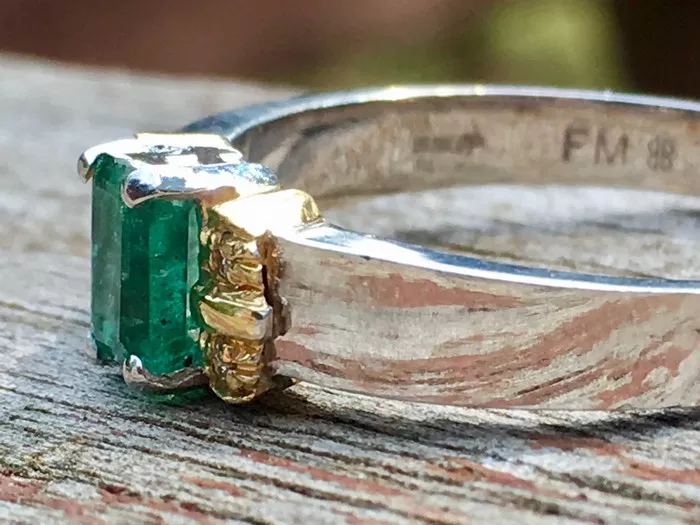Engagement rings and wedding rings are both symbols of love and commitment, but they serve different purposes and traditions within the context of a relationship. While often used interchangeably, these two types of rings have distinct meanings, designs, and significance. This comprehensive guide explores the differences between engagement rings and wedding rings, their cultural significance, evolving trends, and practical considerations for couples navigating this essential aspect of their journey toward marriage.
Understanding Engagement Rings
Engagement rings traditionally symbolize a promise of marriage and are typically given during a proposal. They serve as a symbol of a couple’s commitment to each other and their intention to marry. Key characteristics of engagement rings include:
Design: Engagement rings often feature a prominent center stone, such as a diamond or other gemstone, symbolizing the promise and importance of the commitment.
Timing: Given before the wedding during a proposal, the engagement ring marks the beginning of the engagement period.
Symbolism: The engagement ring represents love, devotion, and the promise of a future together. It is a visible sign of the couple’s intention to marry.
Exploring Wedding Rings
Wedding rings, also known as wedding bands or wedding rings, are exchanged during the wedding ceremony itself. They signify the union and commitment between spouses and are worn daily as a symbol of marriage. Key characteristics of wedding rings include:
Design: Wedding rings are often simpler in design compared to engagement rings, typically without a prominent center stone. They are often made of precious metals such as gold, platinum, or titanium.
Exchange: Exchanged during the wedding ceremony, wedding rings symbolize the couple’s vows and commitment to each other.
Symbolism: Wedding rings represent unity, partnership, and eternity. They signify the ongoing commitment and fidelity between spouses.
Cultural and Historical Significance
1. Engagement Rings
Historical Roots: The tradition of giving engagement rings dates back centuries, with ancient Romans believed to have started the practice of betrothal rings.
Symbolism: Engagement rings symbolize a promise and commitment to marry, signifying the beginning of a new phase in a couple’s relationship.
2. Wedding Rings
Ancient Practices: Wedding rings have ancient origins, with evidence of their exchange dating back to ancient Egypt and Greece.
Symbolism: Wedding rings symbolize the eternal bond and commitment between spouses, representing unity and fidelity in marriage.
Modern Trends and Variations
1. Engagement Rings
Gemstone Varieties: While diamonds remain popular, engagement rings today may feature a variety of gemstones such as sapphires, emeralds, or morganite, reflecting personal style and preferences.
Customization: Many couples opt for custom-designed engagement rings to reflect their unique relationship and personal tastes.
2. Wedding Rings
Matching Sets: Couples often choose matching wedding ring sets that complement each other in design and style, symbolizing their unity as a married couple.
Engraving and Personalization: Wedding rings may be engraved with meaningful dates, initials, or messages to further personalize the symbolism of the marriage bond.
See Also: What Is Average Carat for Engagement Ring?
Practical Considerations
1. Ring Finger Placement
Engagement Ring Finger: Traditionally, the engagement ring is worn on the fourth finger of the left hand, believed to have a vein connected directly to the heart, known as the “vena amoris.”
Wedding Ring Placement: The wedding ring is typically worn on the same finger as the engagement ring, often placed closest to the heart.
2. Timeline and Etiquette
Proposal Etiquette: Engagement rings are typically presented during a marriage proposal, symbolizing the commitment to marry.
Wedding Ring Exchange: Wedding rings are exchanged during the wedding ceremony itself, symbolizing the formal union and commitment between spouses.
3. Budget and Investment
Engagement Ring: Engagement rings often represent a significant investment, reflecting the importance and commitment of the proposal.
Wedding Ring: Wedding rings may vary in cost depending on the materials and design chosen, but they are generally seen as a symbol rather than a financial investment.
Cultural Variations
1. Western Traditions
Ring Exchange: In Western cultures, the exchange of engagement and wedding rings is a well-established tradition, symbolizing the journey from engagement to marriage.
2. Global Practices
Diverse Customs: Different cultures have unique customs and traditions surrounding engagement and wedding rings, reflecting their values and beliefs regarding marriage and commitment.
Conclusion
While engagement rings and wedding rings both symbolize love and commitment within a relationship, they serve distinct purposes and are exchanged at different stages of the marital journey. Understanding the differences between these rings—whether in design, symbolism, or cultural significance—can help couples navigate their choices and traditions as they embark on the path toward marriage. Ultimately, whether choosing an engagement ring to signify a proposal or wedding rings to exchange vows, these rings serve as enduring symbols of love, unity, and lifelong commitment between partners.

